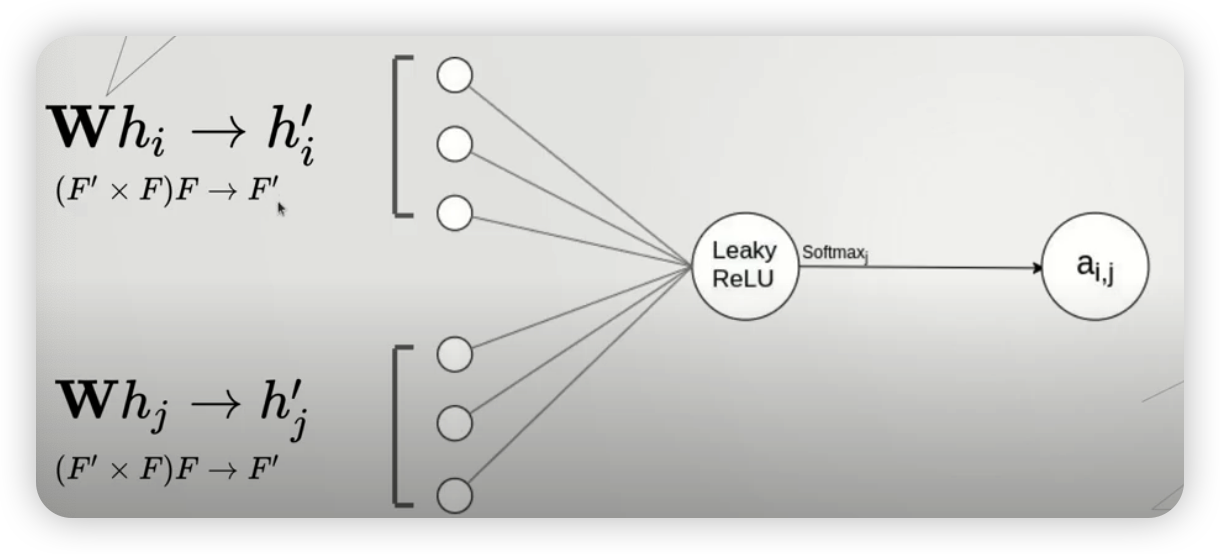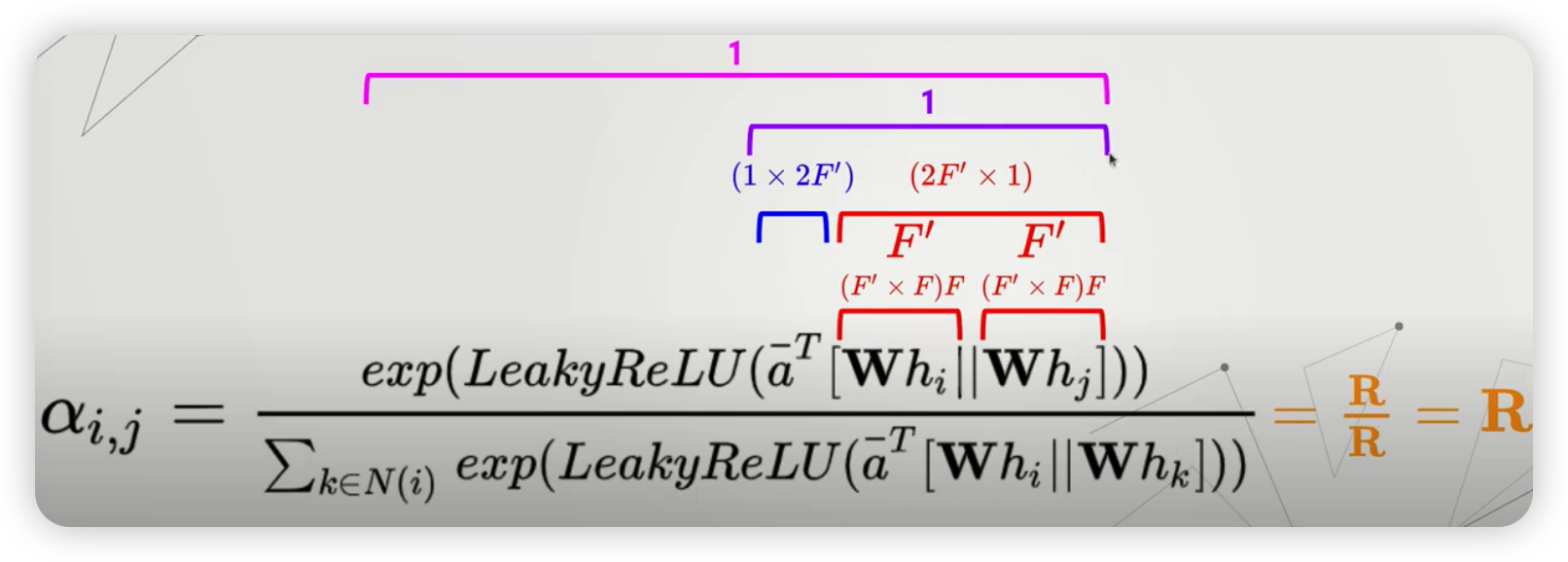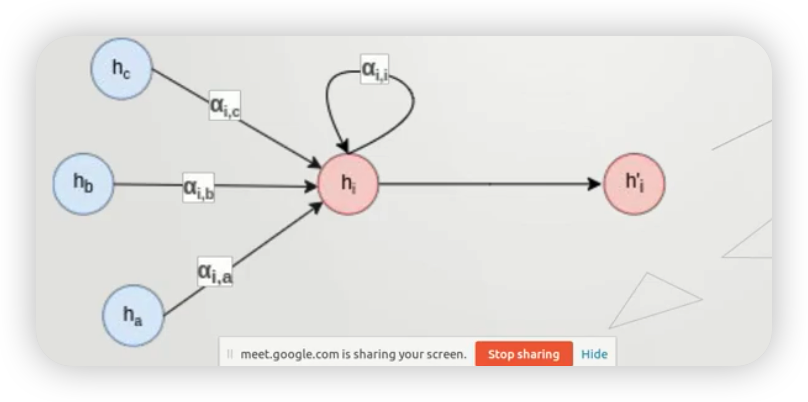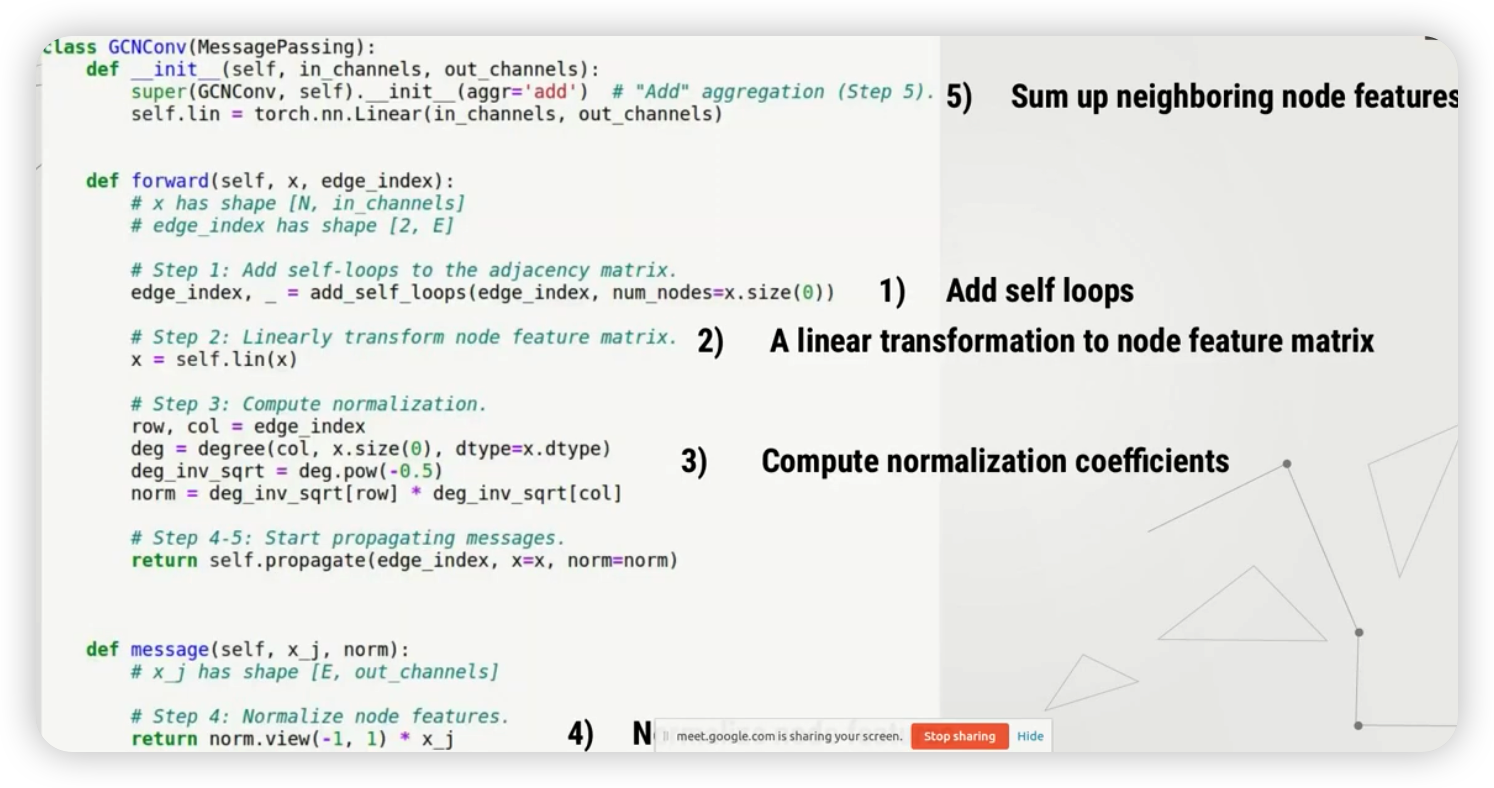Chapter 3. GAT
( 참고 : https://www.youtube.com/watch?v=JtDgmmQ60x8&list=PLGMXrbDNfqTzqxB1IGgimuhtfAhGd8lHF )
1) GAT 요약
Input & Output
-
Input : OLD node feature ( \(\mathbf{h}=\left\{\bar{h}_{1}, \bar{h}_{2}, \ldots, \bar{h}_{n}\right\} \quad \bar{h}_{i} \in \mathbf{R}^{F}\) )
-
Output : NEW node feature ( \(\mathbf{h}^{\prime}=\left\}_{1},{\overline{h^{\prime}}}_{2}, \ldots,{\overline{h^{\prime}}}_{n}\right\} \quad{\overline{h^{\prime}}}_{i} \in \mathbf{R}^{F^{\prime}}\) )
Attention이 이루어지는 과정
- step 1) apply parameterized LINEAR TRANSFORMATION to EVERY node
- \(\mathbf{W} \cdot \bar{h}_{i}\) , where \(\mathbf{W} \in \mathbf{R}^{F^{\prime} \times F}\).
- \(\mathbf{W} \cdot \bar{h}_{i}\) , where \(\mathbf{W} \in \mathbf{R}^{F^{\prime} \times F}\).
-
step 2) SELF-attention
-
\(a: \mathbf{R}^{F^{\prime}} \times \mathbf{R}^{F^{\prime}} \rightarrow \mathbf{R}\).
-
\(e_{i, j}=a\left(\mathbf{W} \cdot \bar{h}_{i}, \mathbf{W} \cdot \bar{h}_{j}\right)\).
( \(e_{i,j}\)의 의미 : importance of node j’s features, to node i )
-
-
(상세) Attention mechanism
-
single NN을 사용한다.
-
ex) 만약 node \(i\) 와 node \(j\) 사이의 attention이 이루어진다면….


-
-
step 3) update node representaiton
- 위에서 계산한 attention score를 가중치로 사용하여 이웃 노드들을 조합한다.
- \(h_{i}^{\prime}=\sigma\left(\sum_{j \in N(i)} \alpha_{i, j} \mathbf{W h} h_{j}\right)\).

Multi-head attention
- 위의 step 3)에서, 단지 하나의 head만이 아닌 여러 head를 사용하여, 보다 풍부한 표현을 잡아낼 수 있다.
- Ex) single-head attention
- \(h_{i}^{\prime}=\sigma\left(\sum_{j \in N(i)} \alpha_{i, j} \mathbf{W h} h_{j}\right)\).
- Ex) multi-head attention - concatenation
- \(h_{i}^{\prime}= \mid \mid _{k=1}^{K} \sigma\left(\sum_{j \in N(i)} \alpha_{i, j}^{k} \mathbf{W}^{k} h_{j}\right)\).
- Ex) multi-head attention - average
- \(h_{i}^{\prime}=\sigma\left(\frac{1}{K} \sum_{k=1}^{K} \sum_{j \in N(i)} \alpha_{i, j}^{k} \mathbf{W}^{k} h_{j}\right)\).
GAT의 장점
- (1) computationally efficient
- 병렬 처리 가능
- (2) different importances 반영 가능
- (3) shared manner to all edges
- (4) transductive & inductive case에 모두 적용 가능
3) 간단한 GCN 구현
\(\mathbf{x}_{i}^{(k)}=\sum_{j \in \mathcal{N}(i) \cup\{i\}} \frac{1}{\sqrt{\operatorname{deg}(i)} \cdot \sqrt{\operatorname{deg}(j)}} \cdot\left(\Theta \cdot \mathbf{x}_{j}^{(k-1)}\right)\).
구현 순서
- (1) add self-loop
- (2) linear transformation ( to node feature matrix )
- (3) compute noramlization coefficients
- (4) normalize node features with 93)
- (5) aggregate (=sum, in GCN) node features

4) Import Packages
import numpy as np
import torch
import torch.nn as nn
import torch.nn.functional as F
5) GAT layer 구현
GAT layer를, torch_geometric의 것을 사용하지말고, 직접 구현해보자
class GATLayer(nn.Module):
def __init__(self, in_features, out_features, dropout, alpha, concat=True):
super(GATLayer, self).__init__()
self.dropout = dropout # drop prob = 0.6
self.in_features = in_features #
self.out_features = out_features #
self.alpha = alpha # LeakyReLU의 alpha 값
self.concat = concat # concat = True / False
# Xavier Initialization
self.W = nn.Parameter(torch.zeros(size=(in_features, out_features)))
self.a = nn.Parameter(torch.zeros(size=(2*out_features, 1)))
nn.init.xavier_uniform_(self.W.data, gain=1.414)
nn.init.xavier_uniform_(self.a.data, gain=1.414)
# Leaky ReLU
self.leakyrelu = nn.LeakyReLU(self.alpha)
def forward(self, x, adj):
#-----------------------------#
# x : node feature ( num nodes , node_feature_dim )
# adg : adjacency matrix ( nodes , nodes )
#-----------------------------#
# (1) Linear Transformation
h = torch.mm(input, self.W)
N = h.size()[0]
# (2) Attention Mechanism
a_input = torch.cat([h.repeat(1, N).view(N * N, -1), h.repeat(N, 1)], dim=1).view(N, -1, 2 * self.out_features)
e = self.leakyrelu(torch.matmul(a_input, self.a).squeeze(2))
# (3) Masked Attention
zero_vec = -9e15*torch.ones_like(e)
attention = torch.where(adj > 0, e, zero_vec)
attention = F.softmax(attention, dim=1)
attention = F.dropout(attention, self.dropout, training=self.training)
h_prime = torch.matmul(attention, h)
if self.concat:
return F.elu(h_prime)
else:
return h_prime
6) GAT 구현
필요한 Packages 불러오기
- 이번엔, 직접 만든 GAT layer가 아닌,
torch_geometric에 내장된GATConv를 이용할 것이다.
from torch_geometric.data import Data
from torch_geometric.nn import GATConv
from torch_geometric.datasets import Planetoid
import torch_geometric.transforms as T
import matplotlib.pyplot as plt
name_data = 'Cora'
dataset = Planetoid(root= '/tmp/' + name_data, name = name_data)
dataset.transform = T.NormalizeFeatures()
print(f"Number of Classes in {name_data}:", dataset.num_classes)
print(f"Number of Node Features in {name_data}:", dataset.num_node_features)
( 사용하는 dataset은, Chapter 1과 동일한 Cora dataset이다 )
- class 종류 수 : 7
- node feature 차원 : 1433
GAT Layer를 사용한 모델 구현
GATConv의 argument
- arg[0] : input 차원
- arg[1] : output 차원
- arg[2] (heads) : head의 개수
- arg[3] (dropout) : dropout ratio
class GAT(torch.nn.Module):
def __init__(self):
super(GAT, self).__init__()
self.hid = 8
self.in_head = 8
self.out_head = 1
# 2개의 GAT layer를 쌓을 것이다.
# ( 2번째 : multi-head attention 사용 )
self.conv1 = GATConv(dataset.num_features, self.hid, heads=self.in_head, dropout=0.6)
self.conv2 = GATConv(self.hid*self.in_head, dataset.num_classes, concat=False,
heads=self.out_head, dropout=0.6)
def forward(self, data):
x, edge_index = data.x, data.edge_index
#-------------------------------------#
# x : (2708, 1433)
# edge_index : (2, 10556)
#-------------------------------------#
x = F.dropout(x, p=0.6, training=self.training)
x = self.conv1(x, edge_index)
#-------------------------------------#
# x : (2708, 64)
# 64 : hid 차원(8) x head 개수 (8)
#-------------------------------------#
x = F.elu(x)
x = F.dropout(x, p=0.6, training=self.training)
x = self.conv2(x, edge_index)
#-------------------------------------#
# x : (2708, 7)
#-------------------------------------#
return F.log_softmax(x, dim=1)
모델 & 옵티마이저 생성
device = torch.device('cuda' if torch.cuda.is_available() else 'cpu')
model = GAT().to(device)
data = dataset[0].to(device)
optimizer = torch.optim.Adam(model.parameters(), lr=0.005, weight_decay=5e-4)
7) 모델 학습
model.train()
for epoch in range(1000):
model.train()
optimizer.zero_grad()
out = model(data)
loss = F.nll_loss(out[data.train_mask], data.y[data.train_mask])
if epoch%200 == 0:
print(loss)
loss.backward()
optimizer.step()
8) 모델 평가
model.eval()
_, pred = model(data).max(dim=1)
correct = float(pred[data.test_mask].eq(data.y[data.test_mask]).sum().item())
acc = correct / data.test_mask.sum().item()
print('Accuracy: {:.4f}'.format(acc))
